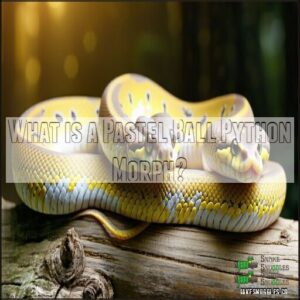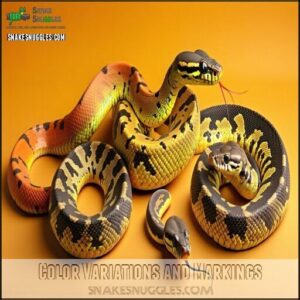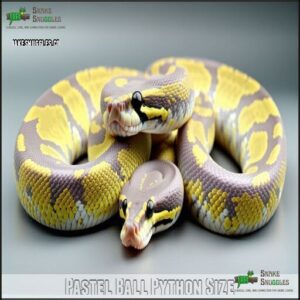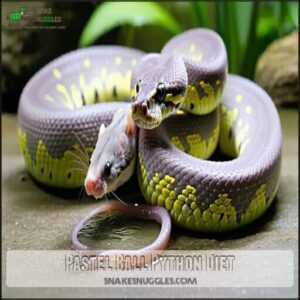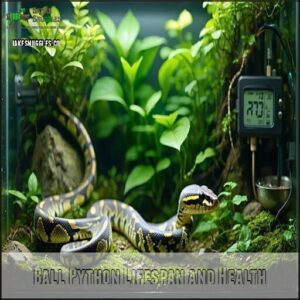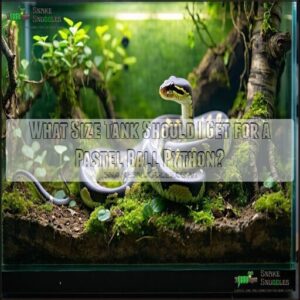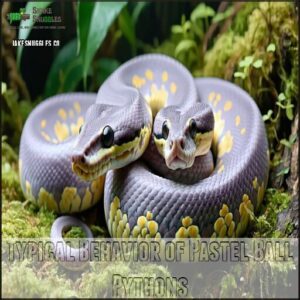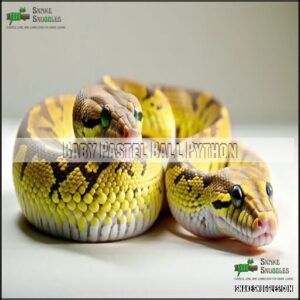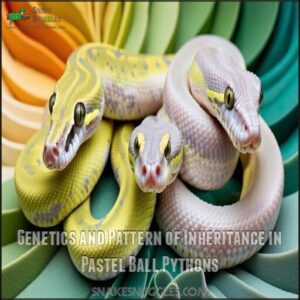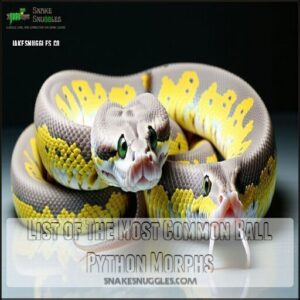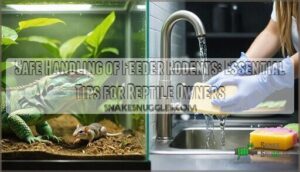This site is supported by our readers. We may earn a commission, at no cost to you, if you purchase through links.

These pythons, scientifically known as Python regius, retain their distinctive alien head markings but with a sun-kissed glow that many enthusiasts can’t resist.
Your pastel’s appearance will actually improve with age—unlike most morphs that fade, these beauties "color up" as they mature.
They’re perfect starter morphs for breeding projects since they combine beautifully with other genetics.
The real magic happens when you pair pastels with complementary morphs to create those jaw-dropping designer combinations that even non-reptile folks can appreciate.
Table Of Contents
- Key Takeaways
- What is a Pastel Ball Python Morph?
- Pastel Ball Python Appearance
- Pastel Ball Python Enclosure
- Typical Behavior of Pastel Ball Pythons
- Caring for a Pastel Ball Python
- Baby Pastel Ball Python
- Genetics and Pattern of Inheritance in Pastel Ball Pythons
- List of The Most Common Ball Python Morphs
- Frequently Asked Questions (FAQs)
- What morph is a pastel Python?
- What morphs combine a pastel ball python?
- What is a black pastel ball python?
- Do ball python morphs have a pastel gene?
- Why are pastel ball python morphs so popular?
- Who bred pastel ball pythons?
- What is a pastel morph ball in python?
- Is pastel recessive?
- What is the most sought after ball python morph?
- What makes a pastel highway ball python?
- Conclusion
Key Takeaways
- You’ll notice pastel ball pythons have distinctive yellow coloration with green eyes, white lips, and a "blushing" effect that creates a dreamy contrast between light and dark patterns.
- Unlike most morphs that fade with age, your pastel ball python will actually "color up" as it matures, becoming more vibrant over time.
- You’ll need to maintain a proper enclosure with a temperature gradient from 75°F (cool side) to 95°F (warm side) and 50-70% humidity for your pastel ball python to thrive for 20-30 years.
- If you’re interested in breeding, you’ll find the pastel gene follows a co-dominant inheritance pattern, meaning breeding two pastels can produce normal ball pythons, pastels, and super pastels with even more intense coloration.
What is a Pastel Ball Python Morph?
Imagine a snake stepping out of a painter’s studio—that’s what a Pastel Ball Python Morph looks like.
These gorgeous reptiles stand out with enhanced yellow pigmentation, clean patterns, and striking green or gold eyes. Their signature characteristic is "blushing," where light hues soften darker markings, creating a dreamy contrast.
This unique morph owes its looks to an incomplete dominant gene, meaning one gene copy brings out Pastel traits, while two copies create even brighter and cleaner Super Pastels. It’s like leveling up your art collection!
Pastel ball python morphs, first discovered in the 1990s, quickly earned a spot in selective breeding for their versatility. They pair beautifully with other snake morphs to create endless stunning combinations.
If you’re into colorful, eye-catching ball python morphs, the Pastel morph is a must-see masterpiece! First discovered at NERD, they became popular in the late 90s.
Pastel Ball Python Appearance
You’ll immediately notice a Pastel Ball Python’s striking yellow hues, clean white belly, and faint blushing that sets it apart.
Their pale green eyes and slightly faded head add unique touches to their vivid coloration.
Color Variations and Markings
Pastel ball pythons are famous for their stunning color variations and intricate markings, making them stand out in any collection.
Their yellow intensity ranges from soft lemon tones to deep golden hues, often glowing brighter as they age.
These snakes also exhibit a fascinating blushing extent, where lighter patches create a dreamy “purple-haze” effect between darker patterns.
A hallmark of the pastel morph is head fading, with pale crowns and white lips that add a touch of elegance.
Their eye coloration—typically green or pale gold—offers a striking contrast to their vibrant scales.
- Yellow Intensity: From subtle gold to radiant saffron
- Blushing Extent: Soft, smoky highlights across the body
- Head Fading: Light crowns with clean white lips
- Eye Coloration: Green or gold hues that pop
Pastel morph characteristics truly redefine ball python color variations.
The pastel’s discovery is traced back to NERD in 1997, marking a pivotal moment in ball python breeding.
Pastel Ball Python Size
Adult pastel ball pythons typically measure 3 to 4 feet, striking a balance between manageable and impressive.
Females often grow larger than males, with some reaching up to 5 feet.
Hatchlings start small, around 10 inches, doubling in size within months.
Proper enclosure size and care substantially influence their growth rate.
Compared to other snake morphs, the pastel morph’s moderate adult size makes it ideal for hobbyists wanting a visually striking yet easy-to-handle ball python morph.
Pastel Ball Python Diet
Feeding your pastel ball python is straightforward with a few handy ball python feeding tips.
Their ball python diet centers around whole rodents, guaranteeing all their nutritional needs are met. Stick to a weekly feeding frequency for most snakes, adjusting for age and size. Prey size matters—choose a rodent no wider than the snake’s thickest part.
Here’s how to keep feeding stress-free:
- Frozen vs Live: Frozen-thawed rodents are safer, but live prey may entice picky eaters.
- Supplementation Needs: None—rodents provide complete nutrition.
- Hydration Methods: Always keep fresh water available.
- Avoid Stress: Skip handling 48 hours post-meal.
Consistency and patience guarantee your pastel morph thrives!
Ball Python Lifespan and Health
A pastel ball python’s lifespan depends on how well it’s cared for. With proper husbandry, these stunning snakes can live 20–30 years—or even longer! Good habitat conditions, regular veterinary care, and attention to their health are key to longevity.
One key to their health is ensuring they’ve the proper thermal gradient in their enclosure.
| Lifespan Factors | Impact | Snake Care Tip |
|---|---|---|
| Heat & Humidity | Influences overall health | Keep 75–95°F, 60% humidity |
| Veterinary Care | Spots early health problems | Schedule annual exotic vet check-ups |
| Genetic Health | Affects durability | Avoid inbreeding during breeding |
Common illnesses, like respiratory infections or dysecdysis, often stem from improper care. Ball python health issues are manageable with effort—think of yearly vet visits as their spa day! Avoid shortcuts in habitat setup, and you’ll help them avoid ball python genetic issues and breeding risks.
Pastel Ball Python Enclosure
You’ll need an enclosure that mimics the tropical environment Pastel Ball Pythons are adapted to, balancing humidity, temperature, and space.
A well-maintained habitat guarantees their health and showcases their vibrant coloration.
What Size Tank Should I Get for a Pastel Ball Python?
When setting up a ball python enclosure, size matters! Hatchlings thrive in a 10-gallon tank, but as they grow, you’ll need to upgrade.
For adults, aim for a spacious 4′ x 2′ x 2′ enclosure to support their full body length and natural behaviors. A minimum of 40 gallons helps facilitate natural snake behaviors.
- **Did you know?
**A tank that’s too large for juveniles can stress them out. Start small and scale up!
Choose between glass tanks, PVC enclosures, or plastic tubs—each has pros and cons. Glass looks great but struggles with humidity, while PVC excels in temperature control.
Add vertical space with branches for climbing, and guarantee the setup promotes enrichment. A happy pastel ball python means better ball python care!
Cleaning & Misting
Keeping your ball python enclosure clean is essential for health. Spot clean weekly, replace the substrate monthly, and disinfect thoroughly. Misting boosts humidity levels, aiding shedding assistance, but daily misting isn’t necessary.
Use tap water only—no disinfectants. To maintain a hygienic habitat, consider using a suitable reptile disinfectant. A clean enclosure guarantees proper ball python care, maintaining a healthy temperature gradient and water quality.
| Task | Frequency | Tools Needed | Notes |
|---|---|---|---|
| Spot Cleaning | Weekly | Gloves, Paper Towel | Remove waste and uneaten food. |
| Substrate Change | Monthly | Fresh Substrate | Choose reptile-safe options. |
| Full Disinfection | Monthly | Cleaning Solution | Sanitize all enclosure elements. |
| Misting | As Needed | Spray Bottle | Use plain water for humidity. |
A clean enclosure is crucial for proper ball python care, and it involves regular tasks such as spot cleaning, substrate change, and full disinfection. By following these tasks and maintaining a clean environment, you can ensure your ball python stays healthy and thrives in its habitat, with a well-maintained temperature gradient.
Typical Behavior of Pastel Ball Pythons
When it comes to temperament, pastel ball pythons are known for their docility and calm demeanor, making them great for beginners.
Like all ball python morphs, they may curl into a tight ball if nervous—an instinctive defense mechanism that’s both endearing and practical.
Their activity levels are generally low, but they’ll explore their enclosure at night.
Be mindful during handling; always support their body fully and avoid sudden movements to build trust and encourage positive social interaction.
Proper enclosure setup is key for their well-being.
Feeding responses can vary, with some individuals being finicky.
If yours refuses food, try smaller prey or scenting techniques.
During shedding behavior, you’ll notice cloudy eyes and dull skin.
Boosting humidity guarantees a smooth process.
- Traits to expect:
- Docile and easygoing temperament.
- Low activity levels, mostly nocturnal.
- Predictable shedding and feeding behavior.
Caring for a Pastel Ball Python
While observing the beautiful patterns of your pastel ball python is delightful, proper care guarantees those stunning colors remain vibrant. Creating the right environment starts with an appropriately sized enclosure—40-gallon tanks for juveniles and 4’x2′ setups for adults.
You’ll want to carefully consider the features of a suitable habitat setup. Your reptile friend needs a temperature gradient from 75°F (cool side) to 95°F (warm side). Maintain humidity levels between 50-70% to prevent shedding issues and support respiratory health.
proper-sized mouse
Weekly feeding with appropriately sized mice keeps your snake healthy. Practice gentle handling techniques for short periods to build trust without causing stress. Include multiple hides and enrichment ideas like branches to encourage natural behaviors.
Watch for common ailments such as respiratory infections and mouth rot—early detection is your best defense in ball python care!
Baby Pastel Ball Python
You’ll notice your baby Pastel Ball Python displays distinctive traits like vibrant yellow pigmentation, high blushing, and green or pale eyes right from hatching.
As your juvenile python matures, its faded head may darken slightly while the clean, unpigmented underside and characteristic white lips remain consistent features of this co-dominant mutation, with the vibrant yellow pigmentation being a notable trait.
Buyer’s Guide
Now that you’ve mastered basic care, it’s time to bring home your perfect pastel ball python.
When shopping on the morph market, follow these four steps:
- Examine morph rarity and confirm genetic lineage documentation
- Research breeder reputation through reviews and reptile forum feedback
- Verify health guarantees and request feeding records
- Check enclosure setup quality, including temperature gradients and hide spots
Ball python morphs vary widely in quality and pricing factors, so take your time finding a responsibly bred specimen that fits your budget.
Many owners also purchase essential supplies online for their new pet, considering factors like budget and quality to ensure the best for their new pet.
How Much is a Pastel Ball Python?
After selecting your baby Python, you’ll want to understand what affects pastel ball python prices.
The cost of a pastel morph depends on several factors: gender (females cost more), age (older snakes are pricier), pattern influence, and breeding costs.
Color impact and rarity substantially increase ball python prices, with exceptional specimens commanding premium rates.
| Morph Type | Price Range | Market Demand |
|---|---|---|
| Basic Pastel | $50-$75 | Stable |
| Female Pastel | $150-$250 | High |
| Super Pastel | $150+ | Growing |
| Pastel Combos | $200-$1,000+ | Variable |
Genetics and Pattern of Inheritance in Pastel Ball Pythons
You’ll find that Pastel ball pythons possess an incomplete dominant (co-dominant) genetic mutation that enhances yellow pigmentation and creates distinctive features like high blushing, green eyes, and white lips.
When you breed two Pastel specimens together, you’ll produce a statistical mix of 25% Super Pastels showing intensified yellow coloration and reduced patterns, 50% regular Pastels, and 25% normal ball pythons.
Following classic Mendelian inheritance principles, this breeding outcome is a direct result of the genetic traits of the parent snakes.
Simple Recessive
Unlike the pastel ball python, simple recessive mutations in ball python morphs require two copies of the gene to display visual traits.
With recessive genes, breeding outcomes follow different Mendelian patterns than pastel’s co-dominant expression.
When working with recessive traits, you’ll encounter visual hets and need to track hidden alleles through generations.
Double recessives require specific breeding strategies, unlike the straightforward genetics of pastel morphs that show visual traits with just one gene copy.
Dominant
Genetics dictate everything in the pastel ball python world through dominance expression.
A single pastel gene creates a stunning visual variation with enhanced yellow tones and distinctive patterning, making this ball python morph immediately recognizable.
The breeding impact is predictable: pair a pastel with a normal, and you’ll get 50% pastel offspring. It’s like flipping a genetic coin!
For enthusiasts pursuing morph identification, the "super pastel" results when two pastel genes combine, intensifying yellows and creating beautiful blushing effects.
This genetic stability makes pastel snakes popular in python genetics projects. Their predictable inheritance patterns and striking appearance explain why the pastel morph remains a cornerstone in reptile morph collections.
Incomplete Dominant / Co-Dominant
While dominant genes show full expression with just one copy, Pastel ball pythons follow a different genetic pattern.
The Pastel gene is codominant (also called incomplete dominant), meaning one copy produces the standard Pastel morph, while two copies create a Super Pastel with intensified traits.
In codominant genetics, visual indicators are clear: heterozygous Pastels display bright yellows and distinct patterns, while homozygous expression in Super Pastels shows dramatically reduced patterns, more vibrant yellow coloration, and that signature "purple-haze" blushing effect.
When breeding two Pastels, you’ll get 25% Super Pastels, 50% Pastels, and 25% Normal offspring.
Polygenetic
Polygenetic traits in pastel ball pythons showcase a tapestry of complex inheritance patterns.
Unlike simple mutations, these stunning reptile morphs rely on multiple genes working together to create their signature appearance.
When you’re examining pastel morphs, you’ll notice trait variation that can’t be explained by just one gene.
Environmental influences can also subtly affect how these genetics express themselves.
Through selective breeding, enthusiasts continue to discover fascinating ball python morph combinations, making each pastel a unique genetic masterpiece that might just belong in your collection.
List of The Most Common Ball Python Morphs
You’ll find the reptile hobby offers over 1,000 distinct ball python morphs, ranging from vibrant Albinos to striking Piebalds, each with unique genetic expressions and phenotypic characteristics.
The following morphs represent the most widely recognized variations you’re likely to encounter in collections, including the popular Pastel with its enhanced yellow pigmentation and distinctive green eyes.
Albino (Amelanistic)
Moving from inheritance patterns to specific morphs, the Albino ball python stands out as one of the most striking variations you’ll encounter. This amelanistic beauty lacks all melanin (black pigment), resulting in a snake with vivid yellow patterns on a pristine white background and distinctive ruby-red eyes.
- Amelanistic ball pythons completely lack melanin production due to a recessive genetic mutation
- When combined with Pastel genes, Albinos develop enhanced yellow tones and subtle pattern refinements
- First established in captive breeding around 1992, revolutionizing the ball python hobby
- Temperature-sensitive coloration becomes more vibrant during warmer months
These snakes aren’t just gorgeous—they’re living showcases of reptile genetics in action.
Caramel (Tyrosinase Positive) Albino
Within the spectrum of ball python morphs, the Caramel (Tyrosinase Positive) Albino stands out with its warm amber tones and subtle blushing. Unlike standard albinos, this variation maintains tyrosinase activity, resulting in rich caramel and honey-colored scales that shimmer under proper lighting.
The genetic mutation affects melanin production differently, creating distinctive visual identification markers—ruby-red eyes surrounded by golden-hued head scales. When combined with pastel genes, these snakes develop enhanced contrast and deeper caramel combinations throughout their pattern.
Breeding outcomes typically follow recessive inheritance patterns, requiring both parents to carry the gene for offspring to display this coloration. Experienced keepers appreciate how this morph’s colors intensify with age, unlike some ball python morphs that fade over time.
Their unique reptile genetics make them fascinating subjects for both collectors and breeders alike, with distinctive visual identification markers and a tendency to develop enhanced contrast. The genetic mutation is a key factor in the development of this morph’s unique characteristics.
Piebald
Piebald ball pythons showcase nature’s artistic flair with their striking white patches against traditional patterns. These eye-catching morphs have captivated enthusiasts for their dramatic, unpredictable designs.
When you’re exploring Piebald Genetics, you’ll find they’re a recessive trait that creates stunning Pattern Variation across specimens. Combining piebald with pastel genes often produces exceptional morph combinations with enhanced colors.
Your Piebald Morph options include:
- High-white specimens (featuring 90%+ white body coverage)
- Low-white varieties (showing minimal white patches)
- "Dalmatian" pied ball pythons (white bodies with scattered dark spots)
- "Pied combos" like Pastel Piebald (adding vibrant yellows to the pattern)
Breeding Outcomes depend entirely on both parents’ genetic makeup.
Axanthic
Unlike the piebald’s striking patches, Axanthic ball pythons showcase a completely different beauty with their high-contrast gray, black, and silver coloration.
These stunning morphs lack red and yellow pigments due to their unique genetics.
| Axanthic Feature | Description |
|---|---|
| Base Color | Gray to silver tones |
| Pattern | High-contrast black markings |
| Eyes | Light, sometimes silvery |
| Breeding Type | Recessive gene |
| Price Range | $300-$600+ for basics |
When combined with pastel genes, Axanthics develop enhanced blushing and remarkable contrast.
You’ll find these python breeding combinations particularly photogenic, with their clean lines and dramatic appearance making them popular among collectors.
Pastel
Pastel ball pythons dazzle with their vibrant yellow coloration and distinctive green eyes.
This co-dominant morph, discovered in the mid-1990s by Greg Graziani and Kevin McCurley, brightens traditional patterns with signature high blushing and clean white undersides.
When two Pastels breed, they can produce Super Pastels with even more striking yellow intensity and reduced patterns.
Beloved by breeders, Pastel genetics serve as the foundation for countless stunning combinations like Pewter and Bumblebee.
Combinations: When One Morph Isn’t Enough
While Pastel ball pythons are stunning on their own, combining them with other morphs creates truly spectacular specimens.
The co-dominant nature of the Pastel gene makes it perfect for complex combos that increase visual appeal and breeding goals.
Here are five popular Pastel combinations that showcase genetic mutations:
- Bumblebee – Pastel + Spider creates vibrant yellow patterns
- Pewter – Pastel + Cinnamon produces silvery hues
- Pastel Clown – Enhances the distinctive clown pattern
- Banana Pastel – Amplifies the purple/orange splotches
- Pastel Pied – Creates stunning high-contrast patterns
Ball python variations are endless when you start mixing morphs!
What Are Ball Python Morphs?
Ball python morphs fascinate reptile enthusiasts worldwide with their remarkable genetic diversity.
These unique color and pattern variations result from natural mutations that breeders carefully isolate and enhance through selective breeding practices.
When you’re exploring snake morphs, morph identification becomes essential as each variation—from the vibrant pastel ball python to the striking albino—represents specific genetic traits.
The morph popularity has exploded since the 1990s, creating thousands of possible combinations that range from subtle pattern shifts to dramatic color transformations.
While you’ll find morphs at various price points, it’s worth noting that this breeding focus has both commercial appeal and potential conservation impact on wild populations.
Frequently Asked Questions (FAQs)
What morph is a pastel Python?
Like a sunrise captured in scales, a pastel ball python is a co-dominant morph with intensified yellow pigmentation, green eyes, white lips, high blushing, and a clean underside.
You’ll notice its distinctive faded head.
What morphs combine a pastel ball python?
You’ll find pastel ball pythons commonly combined with axanthic, bumblebee, clown, and pewter morphs.
These combinations create stunning patterns and colors that’ll make your collection stand out.
Breeders love using pastels as foundation morphs, and they are a key part of creating unique combinations.
What is a black pastel ball python?
Imagine a shadow dancer in serpentine form – that’s your Black Pastel ball python.
You’ll notice its dark, smoky appearance with reduced patterns, often displaying brownish-black coloration and a clean, unmarked belly.
Do ball python morphs have a pastel gene?
Yes, you’ll find the pastel gene is one of the most popular mutations in ball pythons.
It’s a co-dominant trait that enhances yellow pigmentation, creates blushing effects, and produces green eyes when present.
Why are pastel ball python morphs so popular?
Pastel morphs remain popular because they’re visually striking with their vibrant yellows and eye-catching blushing.
You’ll find they’re affordable, widely available, and versatile in breeding projects, creating stunning combinations with other genetic traits.
Who bred pastel ball pythons?
Greg Graziani and Kevin McCurley of NERD independently discovered pastel ball pythons in the mid-1990s. They’re credited with breeding the first captive pastels, initially selling offspring for $2,500 each.
What is a pastel morph ball in python?
Your golden treasure, the Pastel morph, is a co-dominant ball python mutation that enhances yellow pigmentation with high blushing, green eyes, and white lips.
You’ll notice its clean underside and reduced pattern when compared to normals.
Is pastel recessive?
The pastel gene in ball pythons actually follows an incomplete dominant (co-dominant) inheritance pattern.
You’ll find that when breeding two pastels together, you’ll get normals, pastels, and super pastels – not typical recessive behavior.
What is the most sought after ball python morph?
You’ll find the White Wedding morph, with its striking pure white body and contrasting black eyes, is currently the most sought-after ball python morph.
It commands premium prices in the reptile collector’s market, with the White Wedding morph being highly valued.
What makes a pastel highway ball python?
Wondering about snake genetics?
You’ll create a Pastel Highway by combining three genes: Pastel (brightens yellows) with Gravel and Yellowbelly (creating the Highway pattern).
This trio creates a vibrantly colored, distinctively patterned python you’ll love.
Conclusion
Like Midas’s golden touch, pastel ball python morphs transform ordinary pythons into living treasure.
You’ll find these beauties offer the perfect blend of stunning aesthetics and manageable care requirements.
Whether you’re displaying a single pastel or diving into breeding projects, these snakes reward your efforts with increasingly vibrant colors as they mature.
With proper husbandry, your pastel ball python will thrive for decades, offering companionship and a daily reminder of nature’s incredible genetic artistry.
- https://www.researchgate.net/publication/339918500_Searching_for_snakes_ball_python_hunting_in_southern_Togo_West_Africa
- https://www.9news.com.au/world/snake-with-smiley-faces/d121de50-5fa5-4d98-8839-c5d59e35dcb9
- http://basicgenetics.ansci.cornell.edu/lethal_alleles.php?section=mratios
- https://www.inaturalist.org/guide_taxa/257679
- https://www.petmd.com/reptile/ball-python-care-sheet

